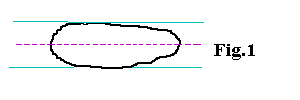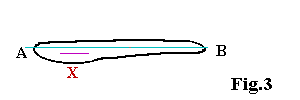Copyright©1996 by W.R. Knapp
OK...I'll admit it. Just don't snicker and talk about it to anyone, okay? As a beginner, for the longest time, I just couldn't grasp the concept of the center line. Now I don't claim to be a genius, but still... I see myself as fairly quick on the draw. So what was the deal?
First I was confusing my working edge with the center line. Then when I realized that wasn't always so I had trouble visualizing just where it was. But finally I got it! Now it seems so painfully obvious to me I wonder why I had so much trouble with it. I don't feel too bad though, because on Craig Ratzats video "Caught Knapping" he says that this concept is a difficult one for some to grasp.
Mastering the center line concept can help you become a more successful knapper because it helps reduce breakage due to hitting too high into the mass of a preform. Later, as you gain experience, you will learn how to "cheat with the angles" so that you don't have to lose as much size due to taking off part of your edge to get below the centerline.
Well, let's explore the center line concept.
First of all understand that we're talking about the center line of the mass. Let's say you have a piece of stone worked down until it's fairly elliptical. It's a preform now. Hold the preform so that you're looking at it edge on. The drawing in Figure 1 shows this view.

As we look at this piece edge on, we imagine a line extending across the top surface, and also one skimming the bottom. This is depicted in figure one by the two light blue lines. Now all we do is split the distance between those two lines exactly in half and imagine a line that extends through the stone (purple dotted line in Fig.1). This is the center line of that mass.(Seems like it could be called "The Center Plane")
Here's the deal. Until you have lots of experience you must promise this to your flintknappin' self. Every time that you are about to strike a platform check to be sure that the place where your billet will connect is below the center line. Platforms made and struck below the center line make flakes. When you hit above the center line you fold the piece!
Next we can take a look at figure two. It shows a preform with an irregular edge. The center line has been drawn in as a light blue line and, as you can see, sometimes the edge is above the center line and sometimes it is below it.

The two places marked with red X's are safe platforms (striking places). Just for kicks you can imagine the preform in figure two turned upside down. Now where are the safe, below the centerline strikes?
You may wonder why I didn't mark the left side as a safe hit even though there is material below the center line. That's because the angle isn't right on that end for an effective strike. It's leaning the wrong way. Platforms have to be at an angle of less than 90 degrees. You would have to chip or pressure flake at that end until the angle was not only below the center line, but also at an angle less than 90 degrees. But check this out! If you turn the preform upside down you have a platform that fits all the criteria just mentioned. On top of that, if you take a flake off there and then turn the piece back over again, you will not only have thinned one side, but with just a little retouch you will also have prepared a platform for taking a flake off the other side. Nice technique!
Finally, lets look at the dilemma presented here by the preform in Figure 3. It's a common scenario, but with experience it's usually pretty obvious. More often you deal with a more subtle version of this example.

We started our light blue center line at end "B" and extended it across the point to end "A". But look what happened to the line when it got to the "A" end. Suddenly it's not in the center of the mass anymore. If we were to strike a platform at this line the piece would very likely fail. The only thing to do is to move the edge down so that our platform would be below the center line of the mass at that end. The real center line of that end is indicated by the purple line. Now we can hit our platform and, providing we're holding the preform at the proper angle, a flake will be removed and things will be very happy. But wait! Before you hit the spot marked with an "X", take a flake or so off from the left end. If you leave too much mass there where the "X" is, you could shock the piece and break it. (For more information on this check out our tutorial on working the ends and then the middle in the article called "Some More Knapping Hints>")
So next time when you're working on a nice piece and you strike and nothing happens but a sick "clunk" noise...STOP! Where's your platform? Whew! You lucked out--it didn't break. Now move that platform down and try again! Good Luck and Happy Chipping!
Back to the Flintknapping section
This page was last updated on 16 March 2012.
Copyright © 1998 & 2012 by Wyatt R. Knapp
Learn about the atlatl and dart system & the physics behind this powerful weapon
The Mysterious Nazca Lines: How were these huge desert glyphs made? Ancient astronauts?
Victory! Outdoorsmen, primitive skills enthusiasts! Find out more here!
History & Primitive Technology Page
Flintknapping: Observations & hints, hafting glue, etc.
Buckskinning Skills: Making gunflints, ancient Firemaking techniques, etc.
Primitive and Traditional Skills Links.
